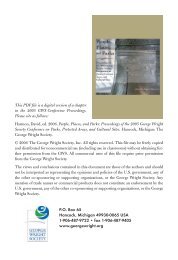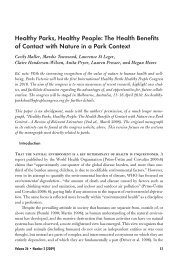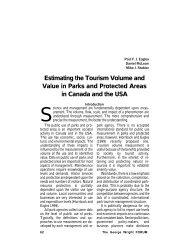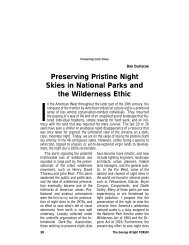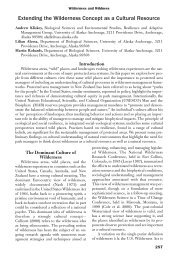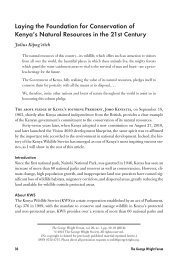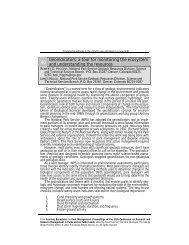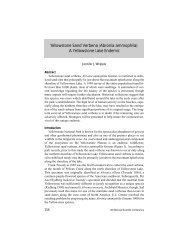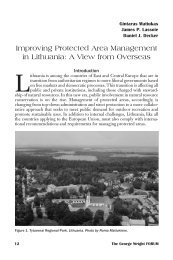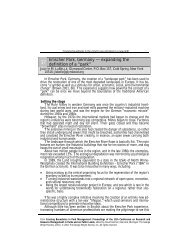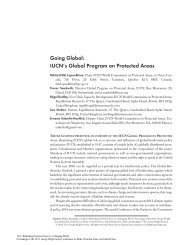Management of Resources-Based Tourism at Tikal National Park in ...
Management of Resources-Based Tourism at Tikal National Park in ...
Management of Resources-Based Tourism at Tikal National Park in ...
Create successful ePaper yourself
Turn your PDF publications into a flip-book with our unique Google optimized e-Paper software.
Ikuko Fujisaki<br />
<strong>Management</strong> <strong>of</strong> <strong>Resources</strong>-<strong>Based</strong><br />
<strong>Tourism</strong> <strong>at</strong> <strong>Tikal</strong> N<strong>at</strong>ional <strong>Park</strong><br />
<strong>in</strong> Northern Gu<strong>at</strong>emala<br />
Introduction<br />
<strong>Resources</strong>-based tourism is <strong>of</strong>ten an economic necessity <strong>in</strong> n<strong>at</strong>ural<br />
resources-dependent communities. <strong>Tikal</strong> N<strong>at</strong>ional <strong>Park</strong>, loc<strong>at</strong>ed <strong>in</strong> the<br />
Petén region <strong>of</strong> northern Gu<strong>at</strong>emala (Figure 1), conta<strong>in</strong>s an ancient<br />
Mayan urban center and was declared a mixed cultural–n<strong>at</strong>ural World<br />
Heritage Site by the United N<strong>at</strong>ions Educ<strong>at</strong>ional, Scientific, and Cultural<br />
Organiz<strong>at</strong>ion (UNESCO) <strong>in</strong> 1979 (N<strong>at</strong>ional Geographic Book Service 1987).<br />
S<strong>in</strong>ce then, the number <strong>of</strong> visitors has been grow<strong>in</strong>g and the park has become an<br />
important tourist <strong>at</strong>traction <strong>in</strong> Gu<strong>at</strong>emala (M<strong>at</strong>ola and Pl<strong>at</strong>t 1998). Currently the<br />
Gu<strong>at</strong>emalan government and non-governmental organiz<strong>at</strong>ions (NGOs) are mak<strong>in</strong>g<br />
efforts to develop resources-based susta<strong>in</strong>able ecotourism <strong>in</strong> the Petén<br />
(Norris and Wilber 1998). This study <strong>in</strong>vestig<strong>at</strong>es the economic contribution <strong>of</strong><br />
<strong>Tikal</strong> to the economy <strong>of</strong> Gu<strong>at</strong>emala and the Petén region, and exam<strong>in</strong>ed visitors’<br />
s<strong>at</strong>isfaction level, <strong>at</strong>titudes toward conserv<strong>at</strong>ion, and demographics to identify<br />
the future possibilities <strong>of</strong> ecotourism promotion <strong>in</strong> the region.<br />
Mexico<br />
Peten<br />
Region<br />
<strong>Tikal</strong><br />
N.P.<br />
Belize<br />
Mexico<br />
GUATEMALA<br />
Nicaragua<br />
Gu<strong>at</strong>emala City<br />
El Salvador<br />
Figure 1. Map <strong>of</strong> Gu<strong>at</strong>emala show<strong>in</strong>g loc<strong>at</strong>ion <strong>of</strong> <strong>Tikal</strong> N<strong>at</strong>ional <strong>Park</strong>.<br />
Volume 19 • Number 2 2002 77
Environmental and<br />
Development Aspects <strong>of</strong><br />
<strong>Tourism</strong> <strong>in</strong> Gu<strong>at</strong>emala<br />
The land area <strong>of</strong> Gu<strong>at</strong>emala is<br />
108,000 sq km, <strong>of</strong> which 35% is covered<br />
with forest (World Bank 1999).<br />
The Gu<strong>at</strong>emalan government’s efforts<br />
to protect historically and n<strong>at</strong>urally<br />
valuable areas <strong>in</strong>creased the number <strong>of</strong><br />
protected areas from 13 <strong>in</strong> 1989 to 17<br />
<strong>in</strong> 1994. From 1989 to 1996 the<br />
extent <strong>of</strong> the protected area est<strong>at</strong>e<br />
nearly doubled, reach<strong>in</strong>g 18,200 sq<br />
km, or 17% <strong>of</strong> the total land area (Figure<br />
2). Intern<strong>at</strong>ional tourism is an<br />
Areas<br />
(Thousand sq. km)<br />
20<br />
15<br />
10<br />
5<br />
0<br />
0.99<br />
8.3<br />
13.3<br />
1989 1991 1993 1995<br />
Year<br />
important source <strong>of</strong> economic growth<br />
<strong>in</strong> Gu<strong>at</strong>emala. Dur<strong>in</strong>g the period<br />
1995-1999, tourism gener<strong>at</strong>ed<br />
US$394 million <strong>in</strong> economic benefits<br />
and cre<strong>at</strong>ed 63,291 jobs n<strong>at</strong>ionwide<br />
(Global InfoGroup 1999), and the<br />
number <strong>of</strong> <strong>in</strong>tern<strong>at</strong>ional tourists<br />
<strong>in</strong>creased 46% (Figure 3).<br />
18.2<br />
Figure 2. N<strong>at</strong>ionally protected areas <strong>in</strong> Gu<strong>at</strong>emala.<br />
The d<strong>at</strong>a are based on World Development<br />
Indic<strong>at</strong>ors (World Bank 1991-1999).<br />
Ecotourism, Conserv<strong>at</strong>ion and<br />
Regional Development<br />
Ecotourism is a grow<strong>in</strong>g segment <strong>of</strong><br />
the world tourism <strong>in</strong>dustry. The term<br />
“ecotourism” is a variant <strong>of</strong> “altern<strong>at</strong>ive<br />
tourism,” <strong>in</strong> contrast to “mass<br />
tourism” (C<strong>at</strong>er and Lowman 1994).<br />
Ecotourism is def<strong>in</strong>ed as tourism to<br />
protected n<strong>at</strong>ural areas and stresses<br />
ecological and sociocultural <strong>in</strong>tegrity,<br />
responsibility, local particip<strong>at</strong>ion, educ<strong>at</strong>ion,<br />
and susta<strong>in</strong>ability (France<br />
1997; Wight 1994).<br />
In the past, it was perceived th<strong>at</strong> an<br />
environmental program could not<br />
contribute to local economic<br />
development, and vice<br />
versa. Currently, it is recognized<br />
th<strong>at</strong> ecotourism could<br />
promote susta<strong>in</strong>able development<br />
th<strong>at</strong> addresses both<br />
economic development and<br />
environmental conserv<strong>at</strong>ion<br />
(Theophile 1995). Advantages<br />
<strong>of</strong> ecotourism <strong>in</strong>clude<br />
diversify<strong>in</strong>g local economies<br />
and achiev<strong>in</strong>g <strong>in</strong>dependence<br />
from the don<strong>at</strong>ions<br />
upon which environmental<br />
programs <strong>of</strong>ten depend.<br />
New employment opportunities<br />
<strong>in</strong> tourism-rel<strong>at</strong>ed<br />
services are the most direct<br />
local benefit. Other possible<br />
economic benefits <strong>in</strong>clude<br />
<strong>in</strong>come from locally produced goods<br />
and fees collected from tourism (Sherman<br />
and Dixon 1997). These benefits<br />
motiv<strong>at</strong>e local communities’ awareness<br />
<strong>of</strong> environmental and resource protection.<br />
Central America is one <strong>of</strong> the<br />
world’s major n<strong>at</strong>ure tourism dest<strong>in</strong><strong>at</strong>ions;<br />
<strong>at</strong> the same time, its n<strong>at</strong>ions are<br />
78<br />
The George Wright FORUM
fac<strong>in</strong>g economic and social difficulties<br />
(Weaver 1994). <strong>Tourism</strong>’s contribution<br />
to the cumul<strong>at</strong>ive regional Gross<br />
N<strong>at</strong>ional Product is 2%. The host-toguest<br />
r<strong>at</strong>io ranges from 0.8:1 to 52:1.<br />
In Gu<strong>at</strong>emala, the estim<strong>at</strong>ed host-toguest<br />
r<strong>at</strong>io was 21:1, rank<strong>in</strong>g <strong>in</strong> the<br />
middle among the 10 Central American<br />
n<strong>at</strong>ions. These countries are promot<strong>in</strong>g<br />
resources-based development<br />
approaches th<strong>at</strong> aim to <strong>in</strong>tegr<strong>at</strong>e susta<strong>in</strong>able<br />
ecological and economic<br />
development (Ashuvud 1991).<br />
However, ecotourism <strong>in</strong> these<br />
countries cont<strong>in</strong>ues to constitute only<br />
Figure 3. Number <strong>of</strong> Intern<strong>at</strong>ional Tourists <strong>in</strong> Gu<strong>at</strong>emala<br />
1995-1999. The d<strong>at</strong>a were provided by the Seción de<br />
Estadistica (Section <strong>of</strong> St<strong>at</strong>istics) <strong>of</strong> Institute<br />
Gu<strong>at</strong>emalteco de <strong>Tourism</strong>o (INGUAT), Gu<strong>at</strong>emala’s<br />
tourism agency.<br />
a small fraction <strong>of</strong> tourist revenues. A<br />
lack <strong>of</strong> local particip<strong>at</strong>ion <strong>in</strong> plann<strong>in</strong>g<br />
and implement<strong>at</strong>ion, and small local<br />
economic absorption <strong>of</strong> benefits gener<strong>at</strong>ed<br />
by ecotourism projects, are still<br />
problems (Whelan 1991). Additionally,over-dependence<br />
on tourism <strong>in</strong>dustries<br />
(Lea 1999; C<strong>at</strong>er 1997) and<br />
<strong>in</strong>creased retail prices, land and property<br />
values, and taxes are potential<br />
neg<strong>at</strong>ive side effects.<br />
Methods<br />
Study site. The Petén, which covers<br />
33% <strong>of</strong> the n<strong>at</strong>ion’s land area, is a<br />
culturally and ecologically significant<br />
region <strong>in</strong> Gu<strong>at</strong>emala. Accord<strong>in</strong>g to the<br />
Consejo Nacional de Áreas Protegidas<br />
(CONAP), the n<strong>at</strong>ional council for<br />
protected areas, all <strong>of</strong> Gu<strong>at</strong>emala’s biological<br />
reserves, 99% <strong>of</strong> its cultural<br />
monuments, and 96% <strong>of</strong> its n<strong>at</strong>ional<br />
parks (56% <strong>of</strong> all protected areas,<br />
exclud<strong>in</strong>g “special protected areas”)<br />
are loc<strong>at</strong>ed <strong>in</strong> the Petén. With<strong>in</strong> the<br />
past few decades, rapid<br />
moderniz<strong>at</strong>ion and<br />
growth have occurred <strong>in</strong><br />
the Petén (Re<strong>in</strong><strong>in</strong>g and<br />
Soza 1998). The<br />
region’s popul<strong>at</strong>ion has<br />
<strong>in</strong>creased from roughly<br />
20,000 <strong>in</strong> 1960<br />
(Schwartz 1990) to<br />
more than 300,000 <strong>in</strong><br />
the mid-1990s. Despite<br />
this, a study revealed<br />
th<strong>at</strong> the region’s <strong>in</strong>come<br />
had decreased substantially<br />
(Ashuvud 1991).<br />
The Gu<strong>at</strong>emala government<br />
expla<strong>in</strong>s th<strong>at</strong> this is<br />
the result <strong>of</strong> a lack <strong>of</strong> efficient<br />
n<strong>at</strong>ural resources<br />
management and str<strong>at</strong>egic plann<strong>in</strong>g <strong>of</strong><br />
the region’s resources use. It requested<br />
the assistance <strong>of</strong> IUCN–The World<br />
Conserv<strong>at</strong>ion Union to formul<strong>at</strong>e a<br />
n<strong>at</strong>ional conserv<strong>at</strong>ion str<strong>at</strong>egy to<br />
improve resources management for<br />
long-term development. Local and<br />
<strong>in</strong>tern<strong>at</strong>ional conserv<strong>at</strong>ion groups also<br />
have been facilit<strong>at</strong><strong>in</strong>g multil<strong>at</strong>eral projects<br />
to develop community-based eco-<br />
Volume 19 • Number 2 2002 79
ments <strong>of</strong> resident and non-resident<br />
visit<strong>at</strong>ion were 6.6% and 6.9%,<br />
respectively. Us<strong>in</strong>g past d<strong>at</strong>a as a<br />
guide, the 2000 visit<strong>at</strong>ion was estim<strong>at</strong>ed<br />
to be 117,787 for residents and<br />
29,291 for non-residents, or 147,078<br />
<strong>in</strong> total.<br />
The survey <strong>in</strong>strument <strong>in</strong>cluded<br />
five types <strong>of</strong> questions: trip characteristics,<br />
expenditures <strong>in</strong> the Petén, s<strong>at</strong>isfaction<br />
level, op<strong>in</strong>ions, and demographics.<br />
The orig<strong>in</strong>al English-language<br />
questionnaire was transl<strong>at</strong>ed<br />
<strong>in</strong>to Spanish, French, German, and<br />
Japanese. A park visitor survey was<br />
conducted dur<strong>in</strong>g May 2000. All<br />
households who were spend<strong>in</strong>g time<br />
<strong>in</strong> the parks’ two ma<strong>in</strong> sites (Gran<br />
Plaza and Temple IV) were asked to<br />
particip<strong>at</strong>e <strong>in</strong> a short on-site <strong>in</strong>terview.<br />
An 87% response r<strong>at</strong>e yielded 341<br />
completed <strong>in</strong>terviews, <strong>in</strong>clud<strong>in</strong>g those<br />
<strong>of</strong> 45 residents and 296 non-residents.<br />
Questionable answers were excluded.<br />
Results<br />
Trip tendency. The non-residents’<br />
number <strong>of</strong> days stayed <strong>in</strong> Gu<strong>at</strong>emala<br />
varied from 1 to more than 100. The<br />
Number <strong>of</strong> visitors<br />
160,000<br />
140,000<br />
120,000<br />
100,000<br />
80,000<br />
60,000<br />
40,000<br />
20,000<br />
0<br />
81 82 83 84 85 86 87 88 89 90 91 92 93 94 95 96 97 98 99<br />
N<strong>at</strong>ional<br />
Intern<strong>at</strong>ional<br />
Year<br />
Figure 4. Number <strong>of</strong> visitors to <strong>Tikal</strong> N<strong>at</strong>ional <strong>Park</strong>, 1981-1999. The d<strong>at</strong>a were provided by<br />
the Seción de Estadistica <strong>of</strong> INGUAT.<br />
tourism and encourage visitors to<br />
explore <strong>at</strong>tractions <strong>of</strong> the Petén.<br />
Accord<strong>in</strong>g to the Ecotravel Center<br />
(www.ecotour.org), because visitors<br />
typically spend only one or two days<br />
<strong>in</strong> the region, the local communities<br />
have received few benefits from<br />
tourism, although tourism is one <strong>of</strong> the<br />
Petén’s primary <strong>in</strong>dustries.<br />
Annual visit<strong>at</strong>ion to <strong>Tikal</strong> N<strong>at</strong>ional<br />
<strong>Park</strong> has grown considerably s<strong>in</strong>ce<br />
World Heritage Site declar<strong>at</strong>ion (Figure<br />
4). From 1981 to 1999, the number<br />
<strong>of</strong> non-resident park visitors<br />
<strong>in</strong>creased eight times to 110,494, and<br />
resident visitors <strong>in</strong>creased 35 times to<br />
27,400. This was 17% <strong>of</strong> visitors to<br />
Gu<strong>at</strong>emala <strong>in</strong> 1999.<br />
D<strong>at</strong>a collection. Between 1990<br />
and 1999, the average annual <strong>in</strong>cre-<br />
average was 17 days, while 58% <strong>of</strong> visitors<br />
spent fewer than 10 days <strong>in</strong><br />
Gu<strong>at</strong>emala. The proportion <strong>of</strong> residents<br />
stay<strong>in</strong>g overnight <strong>in</strong> the Petén<br />
region (78%) was slightly higher than<br />
those <strong>of</strong> non-residents (72%). Sixtythree<br />
percent <strong>of</strong> the non-residents<br />
spent one or two days <strong>in</strong> the region,<br />
while 62% <strong>of</strong> the residents spent more<br />
80<br />
The George Wright FORUM
than three days. On average, residents<br />
stayed longer (3.8 days) than non-residents<br />
(2.8 days).<br />
While 13% <strong>of</strong> non-residents traveled<br />
alone, all the residents traveled<br />
with other people. The average number<br />
<strong>of</strong> household members <strong>in</strong> a party<br />
<strong>of</strong> resident visitors (3.2) was larger<br />
than th<strong>at</strong> <strong>of</strong> non-resident visitors<br />
(1.8). Only 30% <strong>of</strong> the non-resident<br />
visitors were us<strong>in</strong>g package tours.<br />
Estim<strong>at</strong><strong>in</strong>g visitor expenditures.<br />
The mean expenditures per household<br />
per trip with<strong>in</strong> the Petén were<br />
$176.21 for residents and $192.62 for<br />
non-residents (Table 1). Divid<strong>in</strong>g the<br />
average total household expenditures<br />
by the average number <strong>of</strong> accompany<strong>in</strong>g<br />
household members, the average<br />
expenditure per trip per person was<br />
$55.07 for residents and $107.01 for<br />
non-residents. On average, non-resident<br />
visitors spent nearly twice as<br />
much as did residents. Transport<strong>at</strong>ion,<br />
lodg<strong>in</strong>g, and food composed<br />
about 60% <strong>of</strong> total expenditures for<br />
both groups. The “other expenditures”<br />
<strong>in</strong> Table 1 <strong>in</strong>cluded Internet,<br />
telephone, and facsimile services, and<br />
laundry.<br />
Us<strong>in</strong>g the predicted number <strong>of</strong> visitors<br />
to the park, the total annual<br />
expenditures were estim<strong>at</strong>ed as follows:<br />
E n N n + E r N r<br />
where “E n ” and “E r ” are average<br />
household expenditures <strong>of</strong> non-resident<br />
and resident visitors, respectively,<br />
and “N n ” and “N r “ are the estim<strong>at</strong>ed<br />
number <strong>of</strong> days <strong>of</strong> non-resident and<br />
resident visit<strong>at</strong>ion <strong>in</strong> 2000, respectively.<br />
The estim<strong>at</strong>ed direct annual expenditure<br />
was $1.6 million by resident<br />
visitors, $12.6 million by non-resident<br />
visitors, and $14.2 million <strong>in</strong> total<br />
(Table 2).<br />
S<strong>at</strong>isfaction level and op<strong>in</strong>ions.<br />
Overall, the survey participants <strong>in</strong>dic<strong>at</strong>ed<br />
high s<strong>at</strong>isfaction levels with the<br />
service, facilities, and environment <strong>in</strong><br />
the Petén (Figure 5).<br />
For both groups, safety and hotels<br />
<strong>in</strong> the Petén received high r<strong>at</strong><strong>in</strong>gs. For<br />
the residents, <strong>in</strong>form<strong>at</strong>ion availability<br />
and price level received the lowest r<strong>at</strong><strong>in</strong>gs.<br />
Those who were diss<strong>at</strong>isfied with<br />
the price level po<strong>in</strong>ted out the high<br />
prices <strong>in</strong> the region. For non-residents,<br />
<strong>in</strong>form<strong>at</strong>ion availability and<br />
transport<strong>at</strong>ion were the two issues<br />
with the lowest r<strong>at</strong><strong>in</strong>gs. Levels <strong>of</strong><br />
agreement with described st<strong>at</strong>ements<br />
were also converted to numerical values<br />
(Table 3). Chi-square test showed<br />
different levels <strong>of</strong> agreement between<br />
residents and non-residents.<br />
More than 80% <strong>of</strong> the respondents<br />
answered th<strong>at</strong> they were will<strong>in</strong>g to pay<br />
higher entrance fees to support park<br />
conserv<strong>at</strong>ion. Compared with the<br />
non-resident answer, the resident<br />
answer was skewed to “strongly agree”<br />
(Figure 6). The mean value was slightly<br />
higher for resident visitors (3.3)<br />
than for non-resident visitors (3.1).<br />
More than half <strong>of</strong> the respondents<br />
thought th<strong>at</strong> the restrictions imposed<br />
for conserv<strong>at</strong>ion purposes <strong>in</strong> the park<br />
were enough, while nearly 30% <strong>of</strong> the<br />
non-resident visitors did not th<strong>in</strong>k so<br />
(X 2 = 16.91, df = 2, significance =<br />
0.0005). A majority <strong>of</strong> both resident<br />
(66%) and non-resident (53%) visitors<br />
answered th<strong>at</strong> the number <strong>of</strong> the days<br />
they spent <strong>in</strong> the Petén was not<br />
enough (X 2 = 18.16, df = 2, significance<br />
= 0.0005).<br />
Volume 19 • Number 2 2002 81
Table 1. Itemized average household expenditures <strong>of</strong> resident and non-resident visitors.<br />
Demographics. The respondents<br />
were from 32 countries. The five highest<br />
proportions were from the United<br />
St<strong>at</strong>es (26%), Gu<strong>at</strong>emala (14%), England<br />
(11%), Germany (6%), and the<br />
Netherlands (5%). The mean ages <strong>of</strong><br />
resident and non-resident visitors<br />
were similar (Table 4). The largest<br />
proportion <strong>of</strong> visitors was <strong>in</strong> the age<br />
class 21 to 30 for both residents (44%)<br />
and non-residents (53%). The proportion<br />
<strong>of</strong> non-residents th<strong>at</strong> were<br />
between 11 and 30 was 63%. The proportion<br />
<strong>of</strong> males (69%) was more than<br />
twice <strong>of</strong> th<strong>at</strong> <strong>of</strong> females (31%) for residents,<br />
while the female proportion<br />
(57%) was larger than the male proportion<br />
(43%) for non-residents. The<br />
r<strong>at</strong>io <strong>of</strong> s<strong>in</strong>gle to married was exactly<br />
Table 2. Estim<strong>at</strong>ed annual expenditures by park visitors.<br />
equal for residents, while 72% <strong>of</strong> the<br />
non-residents were s<strong>in</strong>gles. Seventyseven<br />
percent <strong>of</strong> residents had less<br />
than $20,000 <strong>in</strong> annual <strong>in</strong>come. For<br />
non-residents, 43% answered th<strong>at</strong><br />
they had less than $20,000, and 78%<br />
answered less than $60,000.<br />
Discussion<br />
The results <strong>of</strong> this survey showed<br />
th<strong>at</strong> despite the park’s <strong>in</strong>convenient<br />
loc<strong>at</strong>ion, people did not stay long <strong>in</strong><br />
the region. However, more than half <strong>of</strong><br />
the survey participants answered th<strong>at</strong><br />
the number <strong>of</strong> days they spent <strong>in</strong> the<br />
Petén was not enough. A previous survey<br />
found th<strong>at</strong> ecotourists were older<br />
than mass tourists, and the age group<br />
45-64 was likely to have more holidays<br />
82<br />
The George Wright FORUM
Issues<br />
Inform<strong>at</strong>ion availability<br />
Price level <strong>in</strong> Peten<br />
Transport<strong>at</strong>ion with<strong>in</strong> Peten<br />
Hotels <strong>in</strong> Peten<br />
Safety <strong>in</strong> Peten<br />
3.0<br />
2.8<br />
2.9<br />
2.8<br />
3.1<br />
3.2<br />
3.2<br />
3.2<br />
3.5<br />
3.4<br />
1.0 1.5 2.0 2.5 3.0 3.5 4.0<br />
Level <strong>of</strong> S<strong>at</strong>isfaction<br />
Non-resident<br />
Resident<br />
Figure 5. Level <strong>of</strong> s<strong>at</strong>isfaction. Mean is based on the scale: 1 = very diss<strong>at</strong>isfied, 2 = diss<strong>at</strong>isfied,<br />
3 = s<strong>at</strong>isfied, 4 = very s<strong>at</strong>isfied.<br />
annually (Boo 1990). However, this<br />
study showed a rel<strong>at</strong>ively young mean<br />
age for visitors, and a majority <strong>of</strong> nonresident<br />
visitors were s<strong>in</strong>gles. The rel<strong>at</strong>ively<br />
low average household <strong>in</strong>come<br />
<strong>of</strong> non-resident visitors was probably<br />
because <strong>of</strong> variability <strong>in</strong> their n<strong>at</strong>ionalities,<br />
their youth, and the large proportion<br />
<strong>of</strong> s<strong>in</strong>gle visitors. Nearly even gender<br />
proportions for non-resident visitors<br />
<strong>in</strong>dic<strong>at</strong>ed th<strong>at</strong> the park <strong>at</strong>tracts<br />
both males and females. Seasonality<br />
may <strong>in</strong>fluence these visitors’ demographics.<br />
Despite residents hav<strong>in</strong>g longer<br />
stays and a larger average number <strong>of</strong><br />
household members travel<strong>in</strong>g with<br />
them, the average household expenditure<br />
<strong>of</strong> non-residents ($192.62) was<br />
higher than th<strong>at</strong> <strong>of</strong> residents<br />
($176.21). The estim<strong>at</strong>ed annual<br />
expenditure <strong>in</strong> the Petén dur<strong>in</strong>g 2000<br />
was $14.2 million. All visitors’ expenditures<br />
may not be locally absorbed.<br />
However, these direct expenditures<br />
should gener<strong>at</strong>e an <strong>in</strong>direct and<br />
<strong>in</strong>duced economic impact, <strong>in</strong>clud<strong>in</strong>g a<br />
general rise <strong>in</strong> <strong>in</strong>come level, cre<strong>at</strong>ion <strong>of</strong><br />
Table 3. Level <strong>of</strong> agreement. Mean is based on the scale: 1=strongly disagree, 2=disagree,<br />
3=agree, 4=strongly agree.<br />
Volume 19 • Number 2 2002 83
Table 4. Demographics <strong>of</strong> visitors.<br />
employment, and <strong>in</strong>creases <strong>in</strong> governmental<br />
tax revenue.<br />
Both groups were highly s<strong>at</strong>isfied<br />
with the facilities, services, and environment<br />
<strong>in</strong> the Petén. <strong>Tourism</strong>-rel<strong>at</strong>ed<br />
facilities, <strong>in</strong>frastructure, and services<br />
<strong>in</strong> the region are probably well developed<br />
to host various types <strong>of</strong> tourists<br />
from abroad. The majority <strong>of</strong> respondents<br />
answered th<strong>at</strong> they were will<strong>in</strong>g<br />
to pay more entrance fees for the<br />
park’s conserv<strong>at</strong>ion. This <strong>in</strong>dic<strong>at</strong>es the<br />
high environmental awareness <strong>of</strong> the<br />
visitors.<br />
Figure 6. Level <strong>of</strong> agreement with St<strong>at</strong>ement 1 (X2 = 9.51, df = 3, significance = 0.025).<br />
Recommend<strong>at</strong>ions<br />
<strong>Based</strong> on the ris<strong>in</strong>g popularity <strong>of</strong><br />
ecotourism and <strong>in</strong>creased visits to<br />
<strong>Tikal</strong> N<strong>at</strong>ional <strong>Park</strong> dur<strong>in</strong>g the past 20<br />
years, use <strong>of</strong> the park will likely<br />
<strong>in</strong>crease <strong>in</strong> the future. Hav<strong>in</strong>g more<br />
visitors will br<strong>in</strong>g a larger ga<strong>in</strong> to the<br />
region’s economy.<br />
There are possibilities for <strong>at</strong>tract<strong>in</strong>g<br />
visitors who would stay longer <strong>in</strong><br />
the region. The wide range <strong>of</strong> ages,<br />
even male and female gender proportions<br />
for non-resident visitors, and rel<strong>at</strong>ively<br />
lower average <strong>in</strong>come <strong>in</strong>dic<strong>at</strong>e<br />
variability <strong>of</strong> visitor types. More than<br />
half <strong>of</strong> the non-resident survey participants<br />
were <strong>in</strong> the age bracket <strong>of</strong><br />
between 11 and 30. These people may<br />
have the flexibility to particip<strong>at</strong>e <strong>in</strong><br />
locally designed ecotourism programs.<br />
Improvement <strong>of</strong> facilities and<br />
services is an issue managers should<br />
address. The issues th<strong>at</strong> showed a<br />
lower s<strong>at</strong>isfaction level, <strong>in</strong>clud<strong>in</strong>g<br />
<strong>in</strong>form<strong>at</strong>ion availability, price level,<br />
and transport<strong>at</strong>ion, should be<br />
84<br />
The George Wright FORUM
addressed first when plann<strong>in</strong>g future<br />
programs. For example, prior <strong>in</strong>form<strong>at</strong>ion<br />
about ecotourism programs and<br />
other n<strong>at</strong>ional parks <strong>in</strong> the Petén<br />
region could <strong>in</strong>fluence the length <strong>of</strong><br />
stays <strong>of</strong> visitors. S<strong>in</strong>ce more than half<br />
<strong>of</strong> the survey participants answered<br />
th<strong>at</strong> the number <strong>of</strong> days they spent <strong>in</strong><br />
the Petén were not enough, there is a<br />
potential to extend visitors’ stay <strong>in</strong> the<br />
region.<br />
Reassessment <strong>of</strong> the park’s conserv<strong>at</strong>ion<br />
measures and entrance fees will<br />
help future management plann<strong>in</strong>g.<br />
Nearly 30% <strong>of</strong> the non-residents<br />
answered th<strong>at</strong> visitor restrictions <strong>in</strong><br />
the park were not enough for environmental<br />
protection. More than 80% <strong>of</strong><br />
the respondents answered th<strong>at</strong> they<br />
were will<strong>in</strong>g to pay a higher entrance<br />
fee for improvement <strong>of</strong> environmental<br />
conserv<strong>at</strong>ion <strong>of</strong> the park. To be environmentally<br />
sound and to promote the<br />
moral and ethical responsibilities <strong>of</strong> all<br />
players are basic premises <strong>of</strong> ecotourism<br />
development (Wight 1994).<br />
These efforts facilit<strong>at</strong>e achievement <strong>of</strong><br />
long-term local and n<strong>at</strong>ional benefits<br />
from resource-based tourism, as well<br />
as susta<strong>in</strong>able resource management.<br />
Acknowledgments<br />
I wish to thank the <strong>in</strong>terviewers, Sergio, Hector, Chie, the members <strong>of</strong> the<br />
Associ<strong>at</strong>ion <strong>of</strong> Guides <strong>Tourism</strong> <strong>in</strong> Petén, José Luis Montúfar <strong>of</strong> CONAP, and the<br />
Seción de Estadistica <strong>of</strong> INGUAT for <strong>of</strong>fer<strong>in</strong>g <strong>in</strong>form<strong>at</strong>ion resources. Special<br />
thanks go to Jon Moris, Dale Blahna, Akiko Ogawa, and Paul Hogue for their<br />
<strong>in</strong>valuable advice.<br />
References<br />
Ashuvud, J. 1991. Environmental conserv<strong>at</strong>ion for development <strong>in</strong> Central America. In L<strong>in</strong>k<strong>in</strong>g the N<strong>at</strong>ural<br />
Environment and the Economy. C. Folke and T. Kaberger, eds. Dordrecht, the Netherlands: Kluwer<br />
Academic Publishers.<br />
Boo, E. 1990. Ecotourism: The Potentials and Pitfalls. Volume 1. Wash<strong>in</strong>gton, D.C.: World Wildlife Fund.<br />
C<strong>at</strong>er, E. 1997. Ecotourism <strong>in</strong> the Third World: Problems and prospects for susta<strong>in</strong>ability. In Earthscan<br />
Reader <strong>in</strong> Susta<strong>in</strong>able <strong>Tourism</strong>. L. France, ed. London: Earthscan.<br />
C<strong>at</strong>er, E., and G. Lowman, eds. 1994. Ecotourism: A Susta<strong>in</strong>able Option? Chichester, U.K.: John Wiley &<br />
Sons.<br />
France, L., ed. 1997. Earthscan Reader <strong>in</strong> Susta<strong>in</strong>able <strong>Tourism</strong>. London: Earthscan.<br />
Global InfoGroup. 1999. En Cifras: Gu<strong>at</strong>emala. Volumen 1, Numero 1 [<strong>in</strong> Spanish]. Antigua, Gu<strong>at</strong>emala:<br />
Global InfoGroup.<br />
Lea, J. 1997. <strong>Tourism</strong>’s economic impacts. In Earthscan Reader <strong>in</strong> Susta<strong>in</strong>able <strong>Tourism</strong>. L. France, ed.<br />
London: Earthscan.<br />
M<strong>at</strong>ola, S., and E. Pl<strong>at</strong>t. 1998. One forest, two n<strong>at</strong>ions: The Chiquibut Forest <strong>of</strong> Belize and Gu<strong>at</strong>emala. In<br />
Timber, Tourists, and Temples. R.B. Primack et al. eds. Wash<strong>in</strong>gton, D.C.: Island Press.<br />
N<strong>at</strong>ional Geographic Book Service. 1987. Our World’s Heritage. Wash<strong>in</strong>gton, D.C.: N<strong>at</strong>ional Geographic<br />
Associ<strong>at</strong>ion.<br />
Norris, R., and J.S. Wilber. 1998. Community-based ecotourism <strong>in</strong> the Maya Forest: Problems and potentials.<br />
In Timber, Tourists, and Temples. R.B. Primack et al. eds. Wash<strong>in</strong>gton, D.C.: Island Press.<br />
Re<strong>in</strong><strong>in</strong>g, C., and C. Soza. 1998. Illum<strong>in</strong><strong>at</strong><strong>in</strong>g the Petén’s throne <strong>of</strong> gold: The ProPetén experiment <strong>in</strong> conserv<strong>at</strong>ion-based<br />
development. In Timber, Tourists, and Temples. R.B. Primack et al. eds. Wash<strong>in</strong>gton,<br />
Volume 19 • Number 2 2002 85
D.C.: Island Press.<br />
Schwartz, N. 1990. Forest society: A social history <strong>of</strong> the Petén, Gu<strong>at</strong>emala. Paper presented <strong>at</strong> the<br />
American Associ<strong>at</strong>ion for the Advancement <strong>of</strong> Science Annual Meet<strong>in</strong>g. 17 February, Atlanta, Ga.<br />
Sherman, P.B., and J.A. Dixon. 1997. The economics <strong>of</strong> n<strong>at</strong>ure tourism: Determ<strong>in</strong><strong>in</strong>g if it pays. In<br />
Earthscan Reader <strong>in</strong> Susta<strong>in</strong>able <strong>Tourism</strong>. L. France, ed. London: Earthscan.<br />
Theophile, K. 1995. The forest as a bus<strong>in</strong>ess: Is ecotourism the answer? Journal <strong>of</strong> Forestry 93:3, 25-27.<br />
Weaver, D. 1994. Ecotourism <strong>in</strong> the Caribbean Bas<strong>in</strong>. In Ecotourism: A Susta<strong>in</strong>able Option? E. C<strong>at</strong>er and<br />
G. Lowman, eds. Chichester, U.K.: John Wiley & Sons.<br />
Whelan, T. 1991. Ecotourism and its role <strong>in</strong> susta<strong>in</strong>able development. In N<strong>at</strong>ure <strong>Tourism</strong>: Manag<strong>in</strong>g for<br />
Environment. T. Whelan, ed. Wash<strong>in</strong>gton, D.C.: Island Press.<br />
Wight, P. 1994. Environmentally responsible market<strong>in</strong>g <strong>of</strong> tourism. In Ecotourism: A Susta<strong>in</strong>able Option?<br />
E. C<strong>at</strong>er and G. Lowman, eds. Chichester, U.K.: John Wiley & Sons.<br />
World Bank. 1991-1999. World Development Indic<strong>at</strong>ors. Wash<strong>in</strong>gton, D.C.: The World Bank.<br />
Ikuko Fujisaki, Sp<strong>at</strong>ial Inform<strong>at</strong>ion Technologies Labor<strong>at</strong>ory, Department <strong>of</strong><br />
Forest <strong>Resources</strong>, Mississippi St<strong>at</strong>e University, Box 9681, Mississippi St<strong>at</strong>e,<br />
Mississippi 39762; ikuko@sorsc.cfr.msst<strong>at</strong>e.edu<br />
❖<br />
86<br />
The George Wright FORUM



